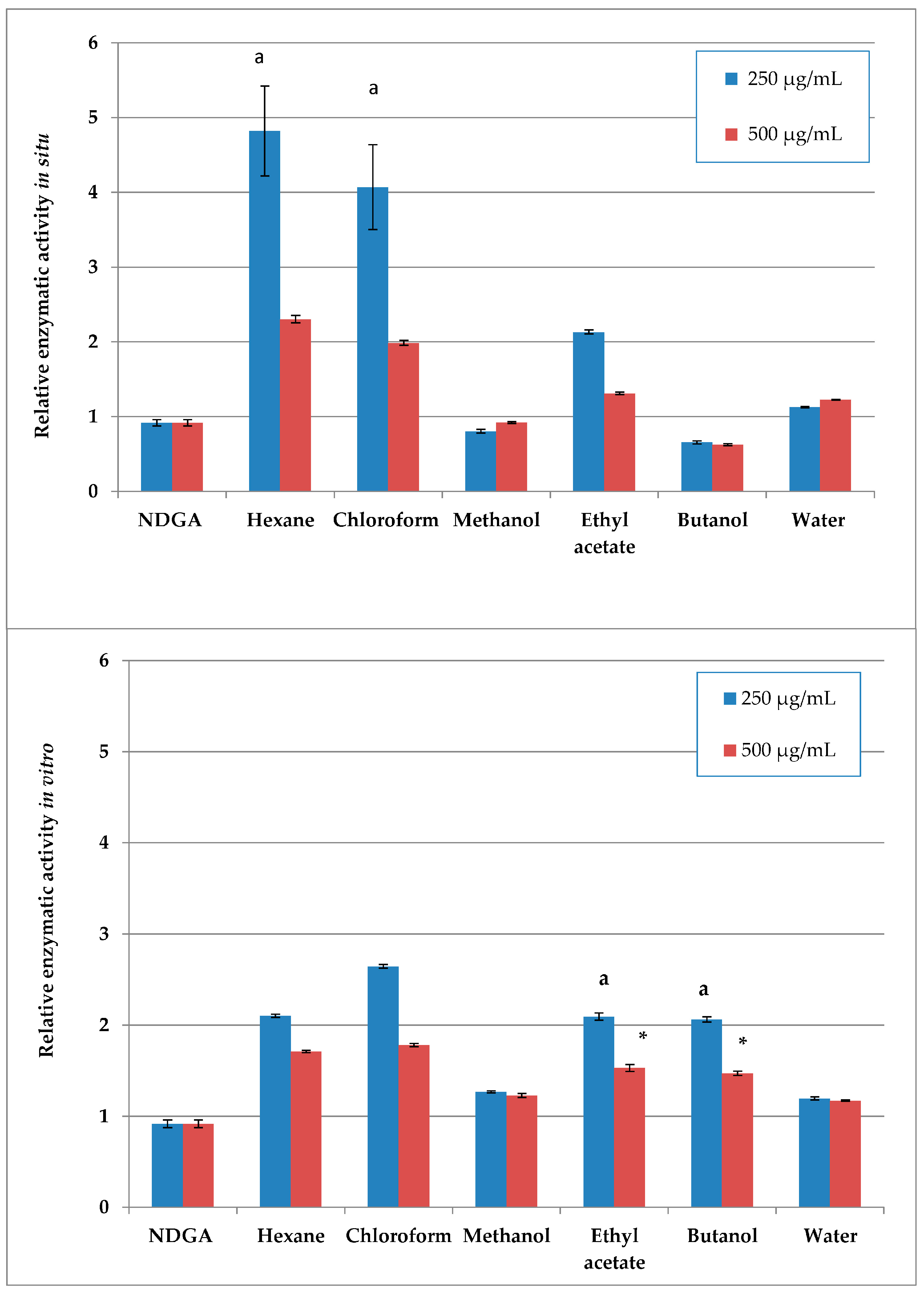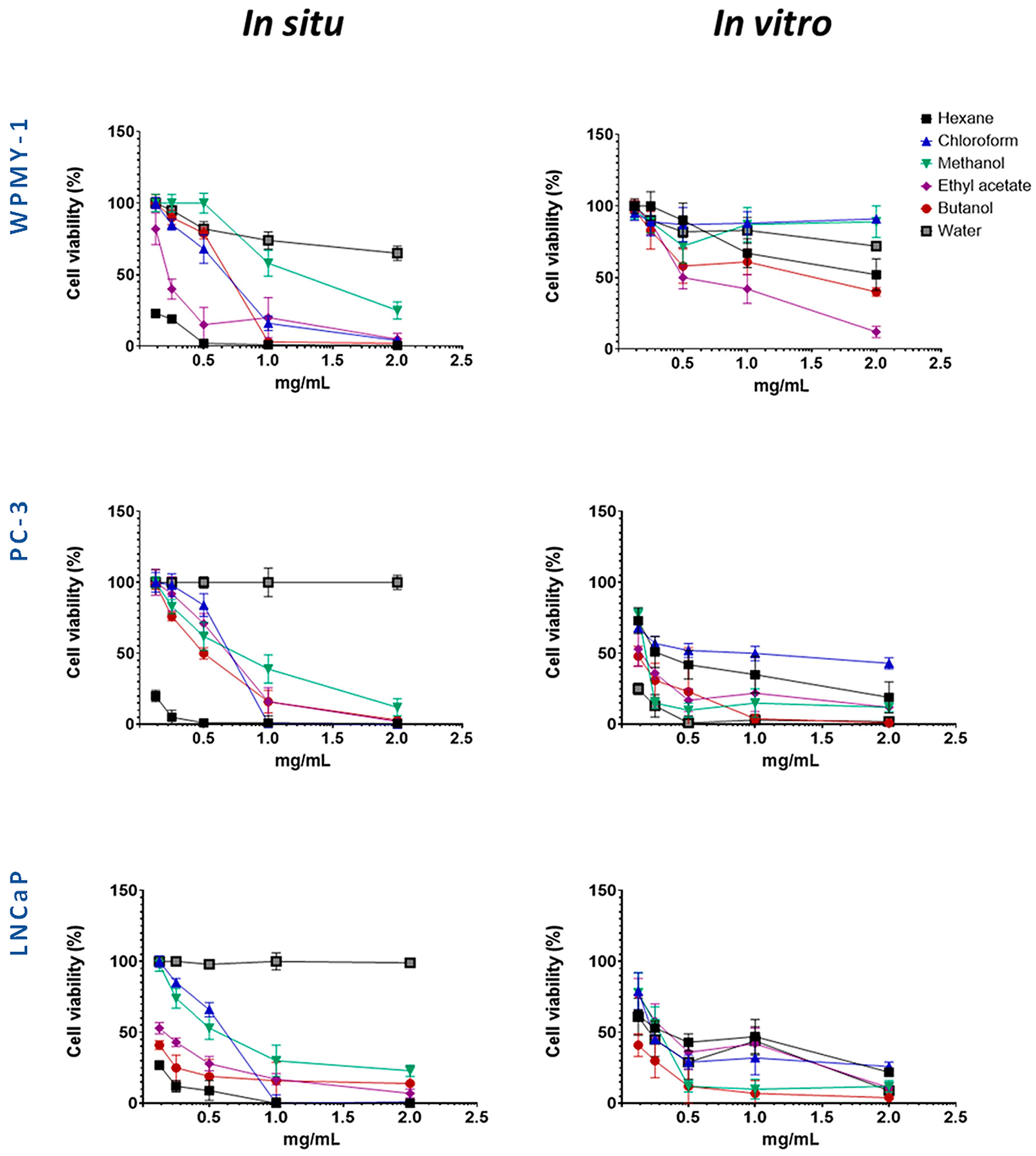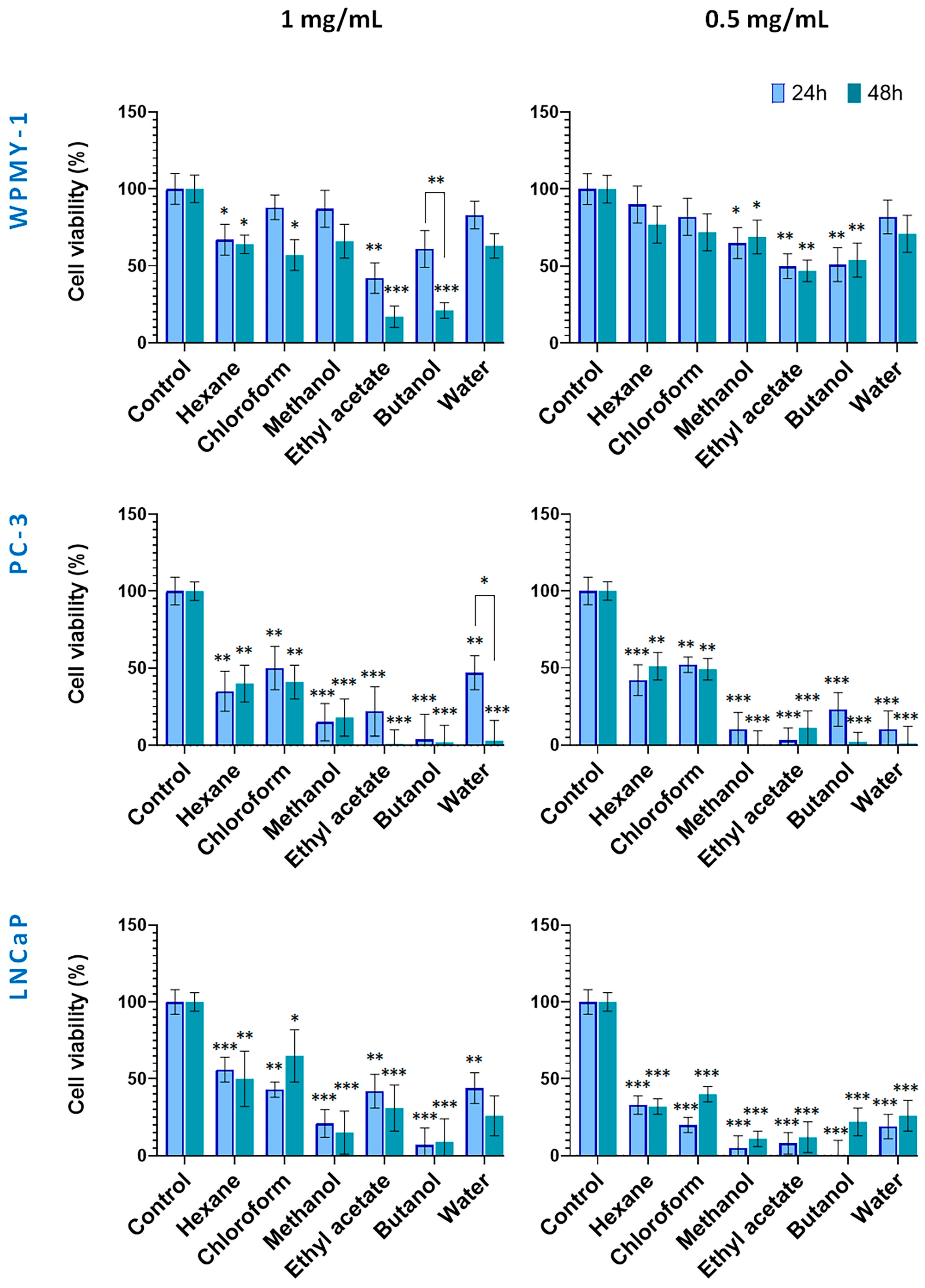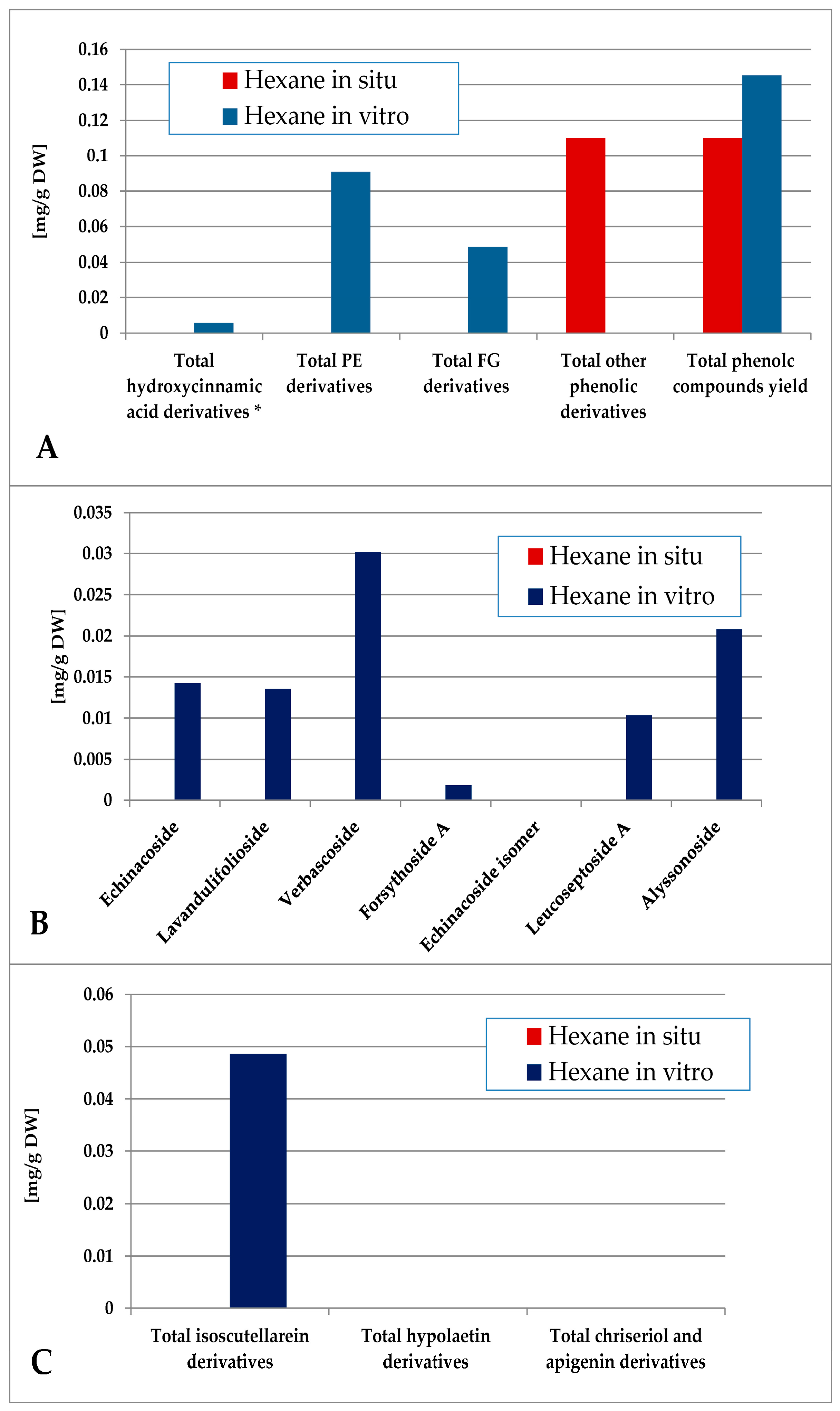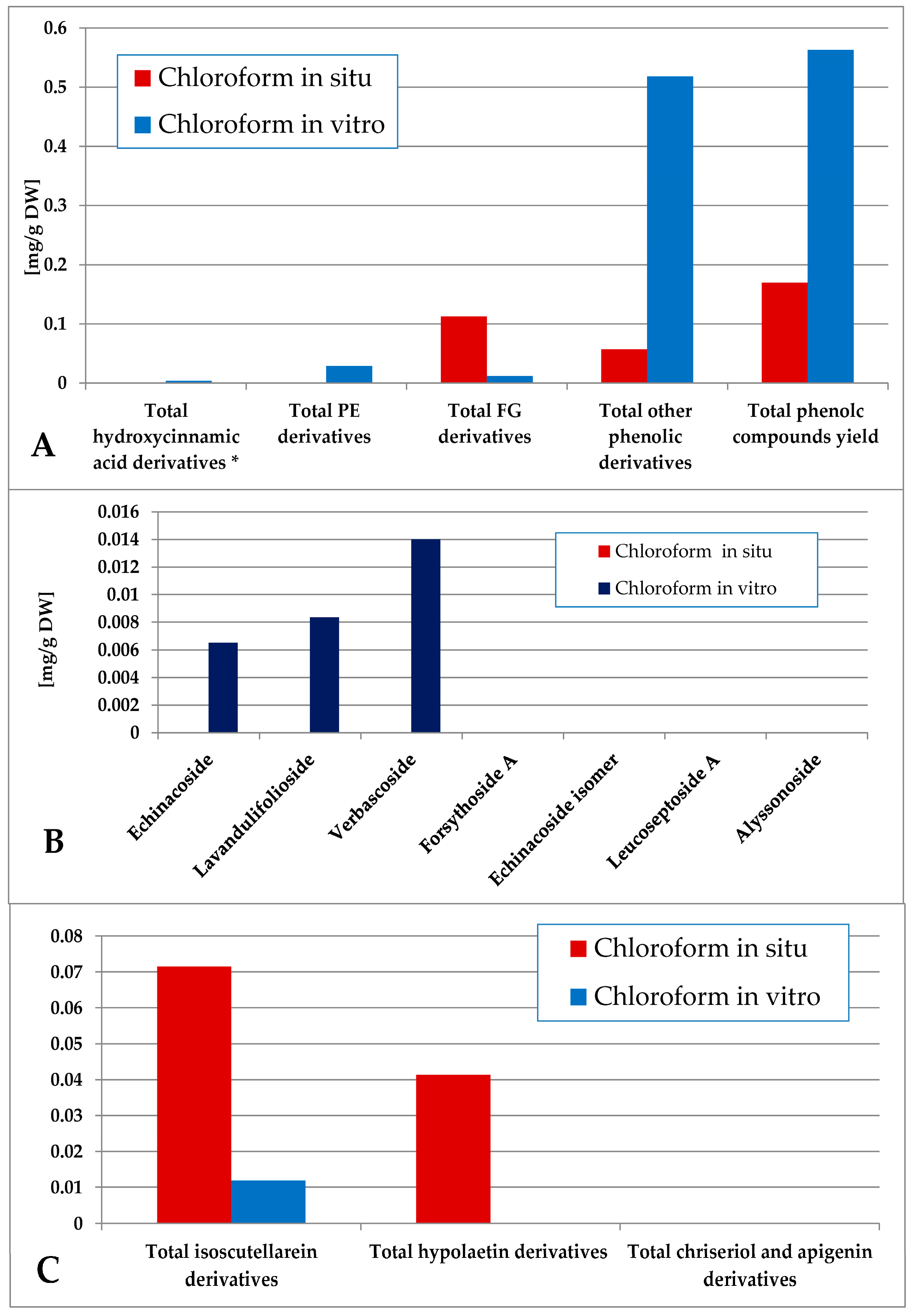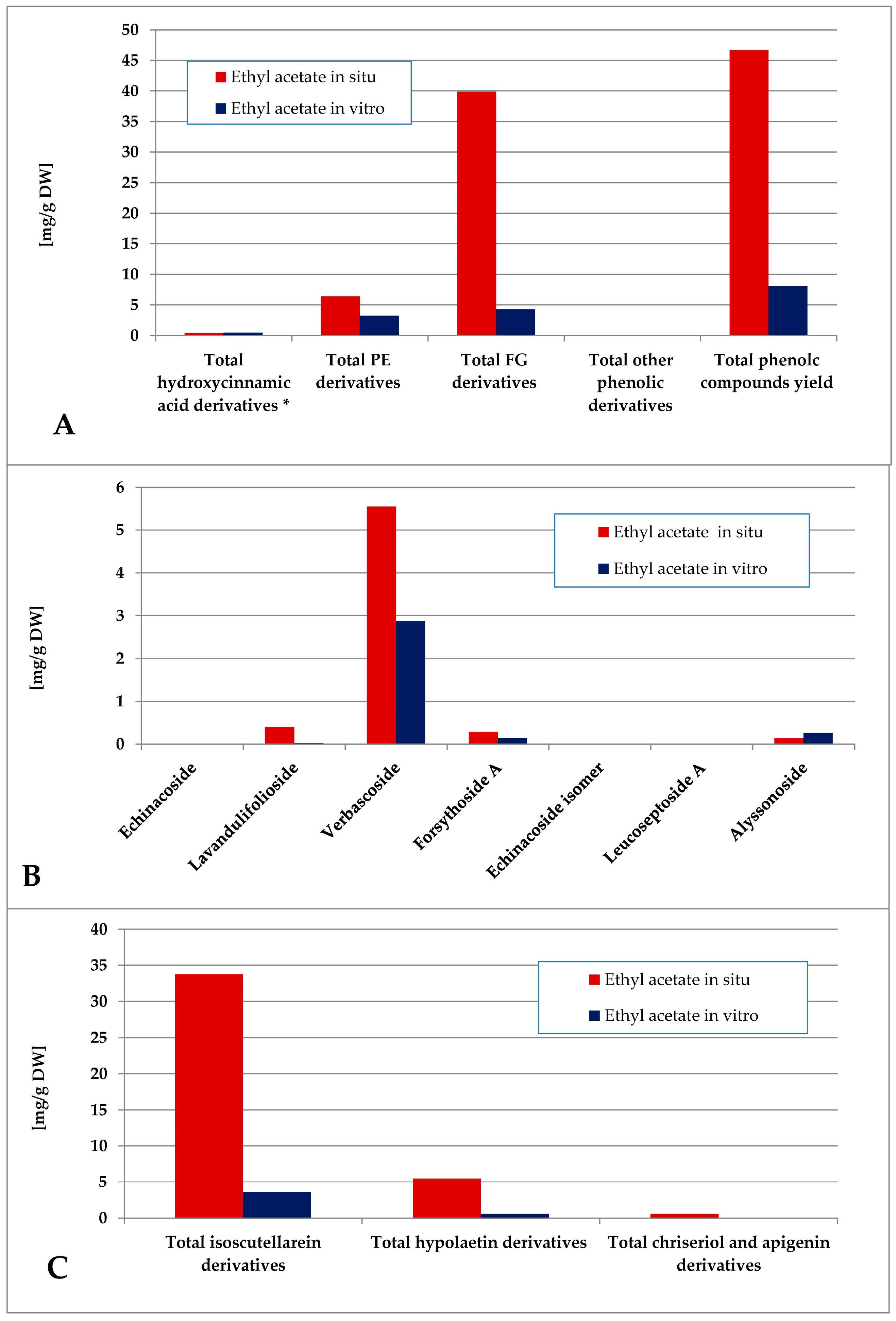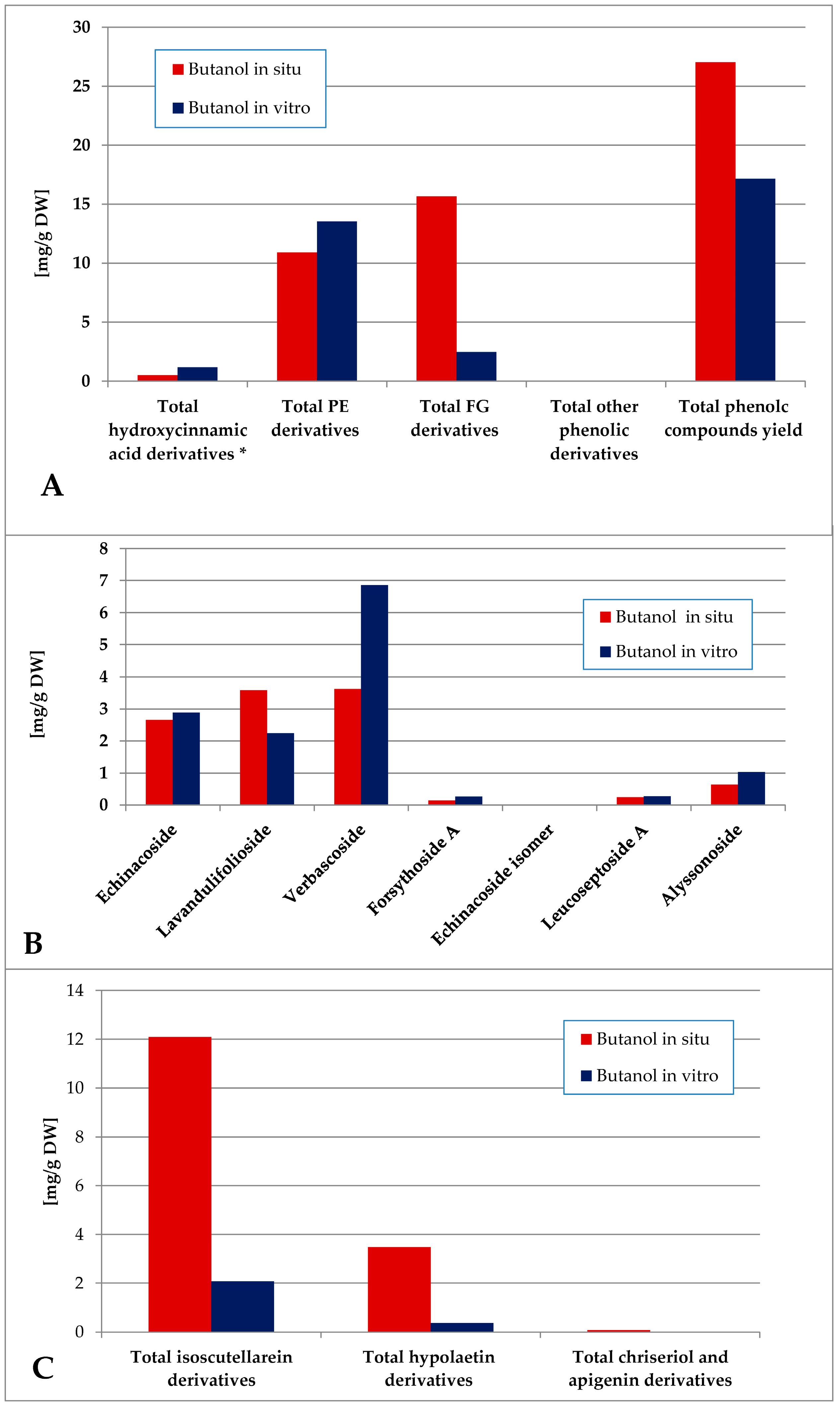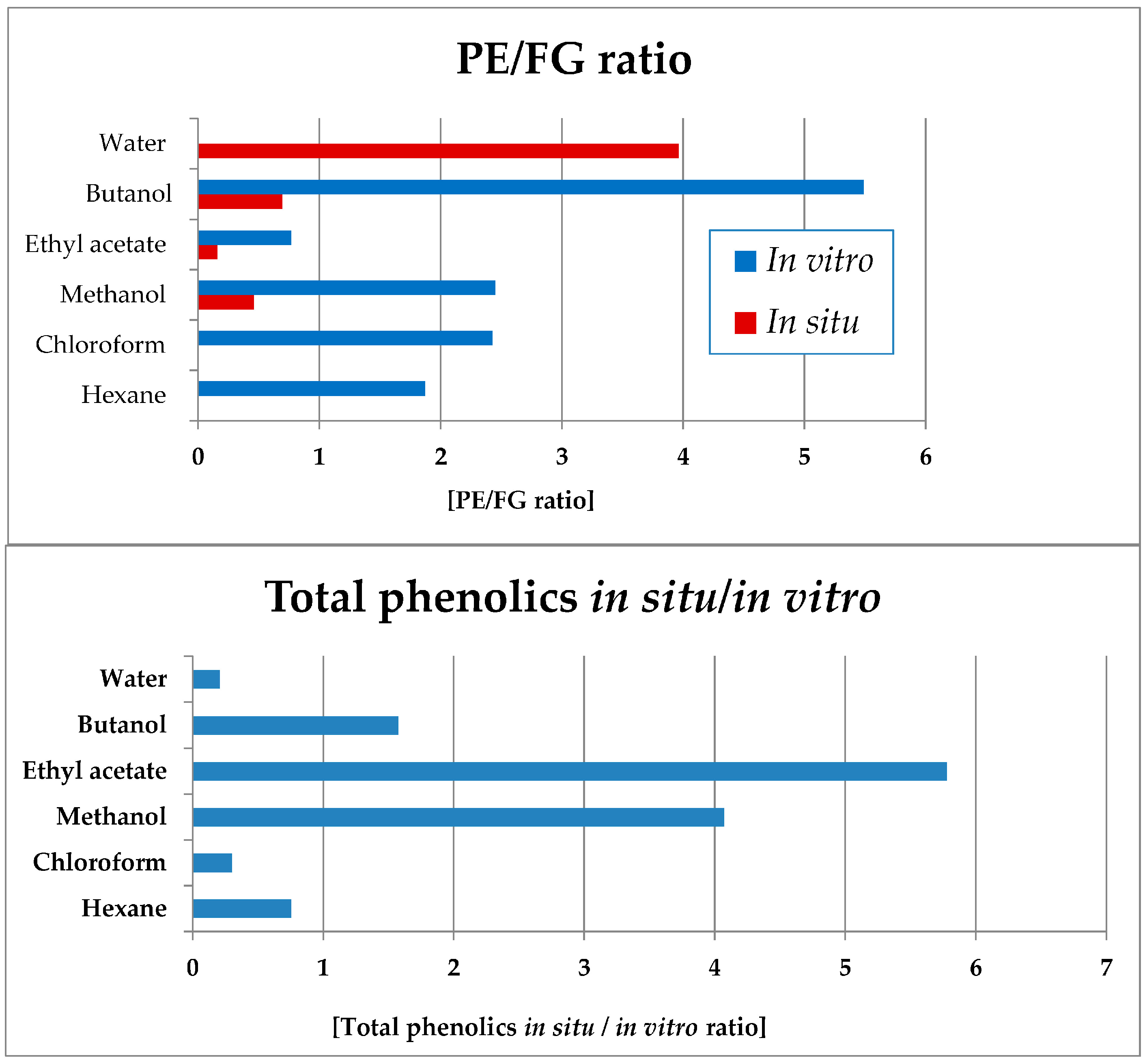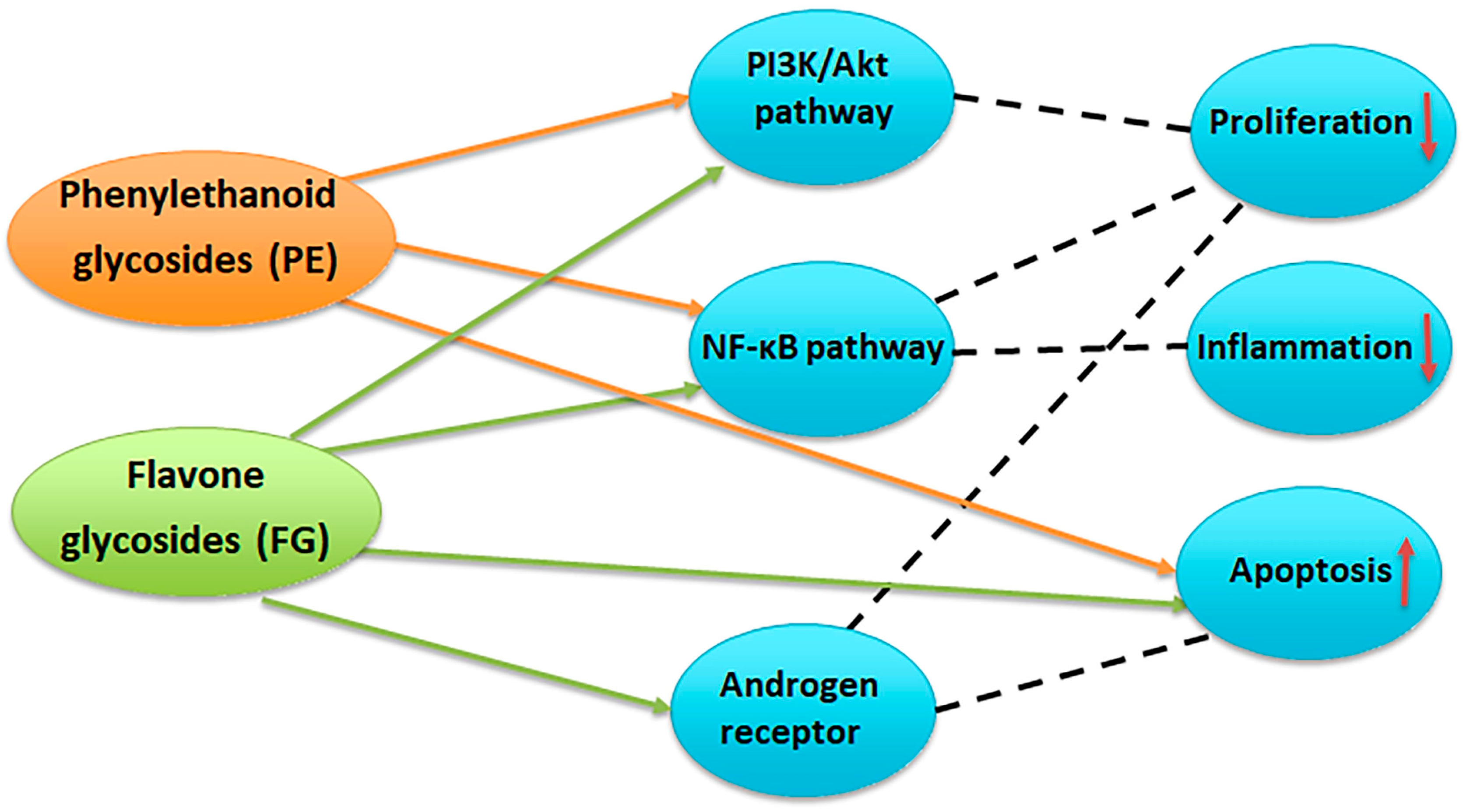1. Introduction
Oncological ailments are an expression of a complex and multifunctional disorder of physiological processes in the human organism. Manifested through the uncontrolled growth of cells, which can invade and spread to distant body locations, they are among the leading causes of illness and mortality worldwide, with approximately 9.6 million deaths in 2018. Lung, prostate, colorectal, stomach, and liver cancer are the most common types of cancer in men, while breast, colorectal, lung, cervical, and thyroid cancer are the most common among women [
1]. Treatment options include surgery, chemotherapy, and radiotherapy, tailored to tumor stage, type, and available resources.
The direct cytotoxicity of certain plant secondary metabolites on cancer cells has led to the discovery of major pharmaceutical chemotherapeutics. About 51% of the officially prescribed anticancer drugs are of plant origin. Remarkable examples of plant-derived anticancer agents are Camptothecin and Taxol, isolated by a bioactivity-directed fractionation of the crude plant extracts. These compounds kill cancer cells by unique and previously unknown mechanisms of action, and together they have been approved for treatment of ovarian, breast, lung, and colon cancers and Kaposi’s sarcoma [
2].
A key factor in cancer genesis is the process of chronic and repeated inflammation, affecting tissue homeostasis and repair [
3]. The functional relationship between inflammation and cancer is not new. In 1863, Virchow suggested the hypothesis that cancer arises at areas of chronic inflammation, based on his presumption that some classes of irritants, together with the tissue injury and the inflammation they cause, enhance cell proliferation [
4]. Thus, it has been considered a prospective approach to harness the inflammatory outburst and normalize the host response of the patient which would lead to decreasing the tumor-promoting properties of the infiltrating cells (i.e., pro-inflammatory cytokines) while increasing their tumor-suppressing properties (anti-inflammatory cytokines) [
5]. Lipoxygenases are non-heme iron (Fe
2+)-containing enzymes incorporating molecular oxygen into polyunsaturated fatty acids [
6]. LOXs and their catalysis products are associated with carcinogenic processes such as tumor cell proliferation, differentiation, and apoptosis [
7]. They are involved in the different aspects of pro- and anti-inflammatory processes in the organism. Several lines of evidence have proven the crucial role of LOXs in cancer. It has also been shown that the 5-LOX metabolite LTB4 is capable of activating the transcription factor NF-κB in cancer cells, which suggests a tumor promoting role via this route [
8]. Thus, in recent decades, LOX inhibitors have raised research interest as a potential new class of anticancer agents [
9].
In vitro cultivation has been shown to support the successful biosynthesis of compounds with anticancer activity in a number of species [
10]. In addition, a number of studies have shown that in vitro cultivation often results in the production of new compounds which are not characteristic for the field-cultivated plant [
11,
12].
The
Sideritis genus, belonging to the Lamiaceae family, encompasses over 150 species with distribution through the temperate and tropical areas of the Northern hemisphere [
13,
14].
Sideritis scardica Griseb. (“Olympus tea”, “Pirin Tea”, or “Mursalski Tea”) is a Balkan endemic species. It is a xerophytic herbaceous perennial, growing at high altitudes over 1000 m a.s.l. [
15,
16]. It is traditionally utilized as a pulmonary treatment, as well as anti-flu and wound-healing remedy [
17]. Recent research has brought insight also into other pharmacologically relevant activities of different preparations of the plant. Different types of its extracts have been shown to possess cytotoxic effects on murine melanoma B16, human leukemia HL-60 cells, as well as C6 rat glioma cells, these effects being attributed to reactive oxygen species induction by the chemical constituents present in the studied preparations [
18]. The latter work showed cytotoxic effects of
S. scardica extracts to be at least partially mediated by the flavonoids apigenin and luteolin. Phenolic components in
S. scardica extracts have been shown by other authors to exhibit dose-dependent anti-inflammatory and gastroprotective activities, as well as cytotoxic activity against cancer cells ([
19] and references cited therein). Phenolic compounds found in
Sideritis species have been systematized in three main types—phenylethanoid glycosides, flavonoid glycosides and phenolic acids [
16,
20,
21,
22,
23]. Recently, Yücer et al. [
24] investigated the anti-inflammatory and anticancer activities of phytochemicals of the
Sideritis genus. By means of literature survey of available data on the genus representatives, the authors set up a chemical library containing 657 chemical components. The survey outlined overall 32% of phenolics, 33% diterpenes and 35% mono-, sesqui-, and triterpenes, sterols, and straight-chain aliphatic compounds as being characteristic for the secondary metabolite pool of the
Sideritis genus. Of the phenolic compound pool, the share of flavonoids and their derivatives was 62% and of phenylethanoids and phenylpropanoids, 7%. Compounds were investigated for their capacity of binding to NLRP3 and NF-κB proteins in silico by virtual drug screening and molecular docking.
S. stricta extracts were also tested in vitro by microscale thermophoresis and phenolic compounds, analyzed by liquid chromatography–high-resolution mass spectrometry. In our previous work, cytotoxicity of commercially obtained
S. scardica sample on MCF7 cells was obtained [
25]. Assessing the cytotoxicity of extracts of in vitro-propagated, ex vitro, and in situ
S. scardica plants has shown promising results on HeLa (cervical adenocarcinoma), HT-29 (colorectal adenocarcinoma), and MCF-7 (breast cancer) human cancer cell lines [
26].
In our previous research, a comparative study of the phenolic profile of wild-collected and in vitro-cultivated
S. scardica Griseb. outlined the capacity of tissue culture-obtained material to accumulate two phenylethanoids and five flavone glycosides, not detected in the wild-collected plant material. In addition, supplementation of activated charcoal in the culture medium was shown to stimulate flavone glycoside accumulation, leading to an elevated flavone/phenylethanoid ratio, as compared with plant growth regulators treatments [
27]. As far as the authors of the present work are aware, there has been no extensive research on prostate cancer and LOX-inhibitory activity of
S. scardica preparations of wild or in vitro-cultivated material. This motivated us to perform a comparative study of the PC cytotoxic potential and LOX-inhibitory capacity of tissue culture and wild-collected
S. scardica.
3. Discussion
The sum of total phenolic compound yield in all in situ plant preparations was 136.29 mg/g DW, and 43.05 mg/g DW for all in vitro preparations (
Figure 5,
Figure 6,
Figure 7,
Figure 8,
Figure 9 and
Figure 10,
Tables S1 and S2), evidencing the higher potential of the wild-collected material to produce phenolic compounds as compared with the tissue culture of
S. scardica Griseb.
Compared to previous reports, which often demonstrated higher phenolic accumulation in
Sideritis species propagated in vitro [
12,
26], our results revealed lower overall phenolic content. This discrepancy may be due to differences in culture conditions (presence/absence of plant growth regulators), elicitation strategies, or extraction protocols, all of which are known to strongly affect metabolite profiles in tissue cultures [
11,
27]. However, the present work demonstrated a distinct enrichment in phenylethanoid glycosides (PEs) in the in vitro as compared to in situ plant material (
Figure 11). In addition, the approach of producing plant preparations with different polarity in the present work led to obtaining interesting dependencies in the allocation of component types, which in turn led to differential effects on the biological activity potential of the in situ- vs. in vitro-obtained preparations. When comparing the profiles of the non-polar (hexane and chloroform)
Sideritis preparations, it was established that a higher proportion of polar compounds was allocated to them in vitro as compared to in situ. This observation is logical given the specificity of the in vitro-obtained plant material—a significantly tenderer cell wall, low amounts of cuticular wax, and the almost missing tissue lignification make in vitro-obtained plant material much more easily extractable. This is also evidenced by the higher extraction yield of all in vitro preparations as compared with the in situ ones (
Tables S1 and S2). Thus, the mechanical effect of ultrasonic extraction has led to the allocation of some of the polar compounds to the non-polar in vitro extracts. It is however important to mention that terpenoid compounds (especially diterpenes present in flowering aerial parts of in situ plant material), which have not been investigated in the present work, could also affect the obtained dependencies and especially the profound cytotoxic effect of the non-polar in situ preparations of the plant.
The above-discussed results on the qualitative and quantitative composition of the obtained
Sideritis preparations outlined the ethyl acetate fraction of the in situ material as the highest in phenolic compound accumulation and most FG-dominated of all in situ- and in vitro-obtained samples (
Figure 5,
Figure 6,
Figure 7,
Figure 8,
Figure 9,
Figure 10 and
Figure 11). On the contrary, all in vitro material preparations were markedly characterized with a significant domination of PE over FG, disregarding the overall lower phenolic compounds levels accumulated in vitro (
Figure 5,
Figure 6,
Figure 7,
Figure 8,
Figure 9,
Figure 10 and
Figure 11).
Extensive research on numerous species has been performed throughout the plant kingdom in the search of bioactive plant preparations or isolated compounds with LOX-inhibitory activity. Among these, as reviewed by Lončarić et al. [
28], are representatives of the families Apiaceae, Asteraceae, Clusiaceae, Fabaceae, Lamiaceae, Melastomataceae, Ericaceae, Menispermaceae, Rosaceae, Sapindaceae, etc. The tested bioactive plant preparations have been obtained with solvents of different polarity (hexane, dichloromethane, chloroform, methanol, ethyl acetate, butanol, and ethanol) and from different plant parts (such as blossoms, fruits, leaves, roots, aerial parts, whole plant and stem bark). Phytochemical analyses of bioactive plant preparations with established LOX-inhibition activity have shown the presence of diterpenoids, lignans, flavonoid glycosides and aglycones, proantocyanidins, phenylethanoids, saikosaponins, terpenoids, coumarins, other phenolic compounds, phenolic acids, steroids, etc.
PC is the most common male malignancy and the second leading cause of the cancer-related deaths [
29]. Prostate cancer (PC) therapy today includes the application of a complex of approaches including radical prostatectomy, radiation therapy, androgen deprivation (in cases of metastatic development), and chemotherapy [
30]. Chemotherapeutic agents most often applied are docetaxel (microtubule assembly inhibitor), as well as its derivative cabazitaxel [
31], the topoisomerase inhibitor mitoxantrone [
32], and estramustine (topoisomerase inhibitor and microtubule inhibitor) [
33]. Most of the PCs are adenocarcinomas with glandular initiation and are characterized by the expression of the AR and PSA markers [
34]. In vitro model systems, utilized for screening the cytotoxicity of potential chemotherapeutic agents for PC, include the two models investigated in the present work. The epithelial PC-3 is a grade IV adenocarcinoma cell line, isolated from bone metastasis of PC. These cells do not express AR and PSA and they possess an androgen-independent proliferation, making hormonal therapy ineffective. PC-3 cells are highly aggressive, unlike most clinical cases of PCs [
34]. On the contrary, the LNCaP line (derived from lymph node metastasis) is AR- and PSA-expressing, being an androgen-dependent adenocarcinoma, with clinical behavior in most of the encountered PC cases [
34]. Research has provided evidence of PC-3 cells expressing features of prostatic SCNCs [
34]. Regarding prostate cancer cell cytotoxicity, higher potential in the present work was established for the FG-enriched fractions. A limitation of the present study is the absence of a conventional drug control, such as docetaxel, which is the first-line chemotherapeutic for advanced prostate cancer. Literature values indicate that docetaxel achieves cytotoxic effects in PC-3 and LNCaP cells at nanomolar concentrations (2–10 nM) [
35], while the
S. scardica preparations tested here required much higher concentrations. Thus, our findings should be viewed in the context of preliminary screening, highlighting selectivity trends rather than pharmacological potency. Moreover, our findings confirm the above-discussed results of Jeremic et al. [
18] on the cytotoxicity of
S. scardica plant preparations, established against rat glioma C6 line, attributed to the luteolin and apigenin present in the plant extracts. Future work will include direct benchmarking of extracts and fractions against docetaxel and other clinically relevant drugs to better evaluate translational potential of obtained tendencies. Numerous plant species have been investigated for their cytotoxic activity on cancer cell lines within the research efforts to identify bioactive preparations with the capacity to inhibit PC cell growth. An extensive review by Thomas-Charles and Fennel [
30] reveals the potential of secondary metabolites of diverse chemical types, which have been found to exhibit cytotoxicity in different PC cell lines. The species are members of the Juglandaceae, Crassulaceae, Moraceae, Fabaceae, Salicaceae, Malpighiaceae, Euphorbiaceae, Meliaceae, Rutaceae, Bixaceae, Malvaceae, Brassicaceae, Lythraceae, Geraniaceae, Lamiaceae, Boraginaceae, Apocynaceae, Asteraceae, Apiaceae, Sapotaceae, Dicksoniaceae, Nephrolepidaceae, Dryopteridaceae, with terpenes, sesquiterpenes, sesquiterpene lactones, naphthoquinones, phenolics, flavonoids, and alkaloids identified in the bioactive plant preparations obtained from them. As discussed above, in their recent work, Yücer et al. [
24] clarified anti-inflammatory and anticancer mechanism features of
Sideritis sp. bioactive compounds by virtual screening and molecular docking. Thus, two biologically active compounds—verbascoside (PE) and apigenin 7,4′-bis(trans-
p-coumarate) (acylflavone)—were identified as the ones with the highest binding affinity towards inflammation-related NLRP3 and NF-κB proteins, with the lower Kd values (higher affinity) being verbascoside for both proteins. Subsequent in vitro experiments provided favorable results for the anticancer activity of verbascoside towards 49 tumor cell lines.
A bibliographic survey on the effects of compounds with PE and FG structure on proliferation, inflammation, and apoptosis (
Figure 12) has shown the overlapping and interrelating roles of the representatives of the two chemical groups. Interestingly, when summarizing the above bibliographical data, the results of the present work seem to be indicative of the possibility of a preferential LOX inhibition of PE-enriched
Sideritis preparations and direct cytotoxicity of FG-enriched preparations, outlining the potential of PE-enriched preparations to target rather the LOX-related events of oncogenic etiology and FG-enriched preparations and thus exhibit higher relevance as direct cytotoxic agents (
Figure 13).
A limitation of this study is that the biological effects observed were not confirmed using purified standards of the identified compounds. Although correlations between phenylethanoid-rich fractions and LOX inhibition, and between flavone glycoside–rich fractions and cytotoxicity, are consistent with literature reports, direct testing of pure standards (e.g., verbascoside, echinacoside, apigenin and luteolin glycosides) is required to clearly establish causality. Future studies will therefore focus on evaluating these compounds individually, either as isolated fractions or commercial standards, to validate their specific roles and to better understand potential synergistic interactions within the complex extract matrix.
This experimental design of the present work was intended to identify relative trends, selectivity, and the potential contribution of different phenolic profiles, rather than to provide precise pharmacological potency values. Future studies will extend these observations by applying full concentration–response analyses of the most active fractions.
Beyond their in vitro relevance, the activities observed suggest a possible translational potential of S. scardica preparations as sources of compounds targeting both inflammation and cancer pathways. To advance towards clinical application, further studies including in vivo efficacy models, pharmacokinetic and toxicological evaluation are required. Importantly, the use of in vitro plant culture provides an innovative route for sustainable production of bioactive metabolites. This not only reduces harvesting pressure on endangered wild populations but also offers advantages such as standardized phytochemical composition, reproducibility, and scalability of biomass production under controlled conditions.
As discussed above, with respect to biological activity, earlier studies have reported the cytotoxicity of
S. scardica extracts in breast (MCF-7), colorectal (HT-29), and glioma (C6) models [
18,
25,
26]. Cytotoxicity of
S. scardica plant preparations, established against rat glioma C6 line, was attributed to the flavonoid glycosides luteolin and apigenin present in the plant extracts [
18]. Our findings extend this knowledge by demonstrating selective effects in prostate cancer cells (PC-3 and LNCaP), which have not been previously addressed. Importantly, the stronger cytotoxicity of flavone glycoside (FG)-enriched fractions observed here aligns with earlier work implicating apigenin and luteolin glycosides in ROS-mediated apoptosis and cell-cycle arrest [
19,
30], while highlighting their potential translational relevance in prostate cancer therapy.
In contrast, LOX-inhibitory activity was predominantly associated with PE-rich fractions in our study, whereas most reports emphasize flavonoids as major LOX inhibitors [
28]. This divergence may reflect structural differences influencing enzyme binding, as verbascoside and related PEs have recently been shown to interact with NF-κB and NLRP3 inflammasome targets [
24], suggesting that their role in inflammation-related cancer pathways may be broader than previously recognized. Thus, our comparative approach adds new mechanistic insight by linking phenylethanoid enrichment to LOX inhibition and flavone glycoside enrichment to cytotoxicity.
These distinctions underscore the novelty of our findings and highlight the need for future mechanistic studies, including gene and protein expression analyses, to reconcile discrepancies with previous reports and clarify the translational potential of S. scardica bioactive compounds.
From a translational standpoint, the present findings suggest that S. scardica preparations may hold promise as sources of lead compounds for drug development targeting inflammation- and cancer-related pathways. Phenylethanoid glycosides, exemplified by verbascoside, could be considered candidates for anti-inflammatory or chemopreventive agents through LOX inhibition and modulation of NF-κB/NLRP3 signaling, whereas flavone glycosides such as luteolin and apigenin derivatives are established inducers of apoptosis and may serve as scaffolds for anticancer therapeutics. Nevertheless, these prospects remain preliminary, as our experiments were limited to in vitro assays. Further translational steps will require testing in in vivo models to define bioavailability, metabolism, and toxicity profiles, followed by dose–response evaluations to determine effective and safe dosage ranges. Such studies are essential before clinical applications or nutraceutical development can be considered.
4. Materials and Methods
4.1. Plant Material and Tissue Culture Conditions
Wild-growing plant material in the flowering stage as well as seeds for in vitro culture development were collected at the Shabran peak, Slavyanka Mountain, Bulgaria (
Figure 14). Stock shoot cultures of the plant were initiated from sterilized wild-collected seeds of the plant as previously described [
27]. In vitro-cultivated plant material for the analyses was cultivated in PGR-free medium supplemented with the Murashige and Skoog [
41] salts and Gamborg [
42] vitamins, 2 mg/L glycine, 30 g/L sucrose and solidified with 6.0 g/L agar (culture media were in-lab prepared by stock-solutions prepared from salts and chemicals, Duchefa Biochemie B.V, Haarlem, The Netherlands). Shoots were cultivated at 25 ± 1 °C at 16/8 h photoperiod for an 8-week period (
Figure 14).
The in vitro-obtained plant material was collected and air-dried in a dessicator until constant weight.
4.2. Preparation of In Situ and In Vitro Sideritis Plant Samples
Based on the diverse content of biologically active compounds with variable polarity characteristic for the Sideritis genus, our aim was to obtain extracts and fractions in which chemical constituents will be differentially distributed. Extraction was aimed to initially defat plant material and then fractionate the methanol extract, rich in a mixture of polar compounds into three separate fractions. Air-dried plant material of the wild-collected and in vitro-cultivated S. scardica Griseb. was extracted in triplicate in ultrasonic bath for 10 min at room temperature in the following steps: consecutive hexane, chloroform, and methanol extracts were obtained, followed by liquid/liquid fractionation of the methanol extract to obtain its ethyl acetate, n-butanol, and water fractions. For each of the three extractions with each of the solvents, the ratio of plant material to solvent was 20 mL solvent per gram of DW.
Extracts were evaporated till dry in a rotary vacuum evaporator and kept at −18 °C prior to analyses.
4.3. 15-LOX-Inhibition Assays of Plant Samples
Analyses were performed by means of the Lipoxygenase Inhibitor Screening Assay Kit, Cayman Chemical, Ann Arbor, MI, USA. Arachidonic acid was used as a substrate, Nordihydroguaiaretic acid (2.5 µM, IC
70 at our experimental conditions) as the inhibition control, and 15-LOX standard as positive control. The absorption of the following samples was measured: optical blank of the assay—consisting of the kit assay buffer; positive control sample—15-LOX reference suspended in the in assay buffer;
100% initial activity sample—15-LOX suspended in assay solvent (DMSO); inhibitor sample—15-LOX and tested plant preparation samples suspended into the assay solvent (DMSO). After incubation, a reaction was initiated with the addition of the substrate (arachidonic acid) and kit chromogen reagent. Absorbance was measured at 490–500 nm. The inhibition percentage of each inhibitor was assayed according to the kit protocol and determined using the following formula:
Results were processed and presented as the relative enzyme activity, calculated as the LOX activity upon application of each of the tested inhibitors, as percentage of the 100% initial activity sample of LOX. Values are normalized to the 2.5 µM Nordihydroguaiaretic acid inhibition (IC
70 at our experimental conditions) accepted as a reference unit. Plant preparations were tested at concentrations of 250 and 500 µg/mL. Treatment concentrations were selected based on a literature survey of similar works performed by other authors [
28]. In order to select the most potent of the preparations in the two tested concentrations, we compared their activity with the one of the NDGA concentrations exhibiting IC
70 in our experimental conditions.
4.4. Cytotoxicity Assays of Plant Samples
The cytotoxic activity of S. scardica extracts and fractions was evaluated using two human prostate cancer cell lines, PC-3 (epithelial adenocarcinoma, Grade IV) and LNCaP (epithelial carcinoma), as well as a normal human prostate stromal cell line, WPMY (epithelial fibroblast/myofibroblast). All cell lines were obtained from the American Type Culture Collection (ATCC, Manassas, VA, USA). PC-3 and WPMY cells were cultured in low-glucose DMEM supplemented with 10% and 5% FBS, respectively. LNCaP cells were maintained in RPMI-1640 medium supplemented with 10% FBS.
The cytotoxic effects were assessed using the MTT assay. Cells were seeded in 96-well plates at a density of 2 × 104 cells/well in 100 μL of the appropriate culture medium. After 24 h of incubation, test samples were added. Immediately before use, the dried extracts and fractions were initially dissolved in DMSO at a stock concentration of 200 mg/mL and then diluted in culture medium to the required working concentrations. To minimize any potential solvent effects, the final concentration of DMSO in all wells was maintained below 1%.
Cell viability was determined by adding 10 μL of MTT solution (5 mg/mL) to each well. Cells were then incubated for 3 h at 37 °C in a humidified atmosphere containing 5% CO
2. Viable cells reduced the yellow MTT salt to insoluble purple formazan crystals. To solubilize the crystals, 100 μL of the solubilization solution (40% dimethylformamide and 16% sodium dodecyl sulfate in 2% glacial acetic acid, pH 4.7) was added to each well, and the plates were then incubated for an additional 20 min at 37 °C with shaking. Absorbance was measured at 544 nm using a FLUOstar OPTIMA microplate reader (BMG Labtech, Ortenberg, Germany). Data from three independent experiments in triplicate were expressed as a percentage of the absorbance relative to untreated control cells (mean of treated wells/mean of untreated control wells) × 100%. DMSO was used as a negative control. The half-maximal inhibitory concentration (IC50) of each
S. scardica extract and fraction was determined using concentrations ranging from 0.125 to 2 mg/mL. The cells were exposed to the plant preparations for 24 h, and the IC50 values were calculated using GraphPad Prism 8 (
Table 1,
Figure 2).
4.5. Phytochemical Characterization of Plant Samples
Chromatographic separation was carried out on a C18 Eclipse column (150 × 4.6 mm, 5 µm; Agilent, Santa Clara, CA, USA) using a mobile phase composed of 1% formic acid in water (A) and 1% formic acid in methanol (B). A linear gradient was applied: 35% B at 5 min, increasing to 50% at 30 min, reaching 100% at 35 min, and held until 55 min. The flow rate was 0.4 mL/min, and the injection volume was 20 µL.
The HPLC system (Agilent 1100 Series) with diode array detector and coupled to an ion trap mass spectrometer was used for analysis. UV spectra were recorded between 190 and 600 nm and mass detection was performed in negative electrospray ionization (ESI) mode, using nitrogen as the nebulizing gas (65 psi, 12 L/min), with a capillary temperature of 325 °C and ionization voltage of 4 kV. Full scan data were collected over m/z 100–1200.
Phenolic compounds were identified based on retention times, UV-Vis spectra and mass spectra compared with authentic standards and literature data [
16,
20,
22,
43].
Reference standards of 5-caffeoylquinic acid,
p-coumaric acid, verbascoside and apigenin 7-
O-glucoside of analytical grade were purchased from Sigma Aldrich (St. Louis, MO, USA), hypolaetin 7-
O-[6‴-
O-acetyl]-allosyl(1 → 2)glucoside, 4′-
O-methylhypolaetin 7-
O-[6‴-
O-acetyl]-allosyl(1 → 2)glucoside, 4′-
O-methylhypolaetin 7-
O-[6‴-
O-acetyl]-allosyl-(1 → 2)-[6″-
O-acetyl]-glucoside, isoscutellarein 7-
O-[6‴-
O-acetyl]-allosyl(1 → 2)glucoside, isoscutellarein 7-
O-[6‴-O-acetyl]-allosyl-(1 → 2)-[6″-
O-acetyl]-glucoside and 4′-
O-methylisoscutellarein 7-
O-[6‴-
O-acetyl]-allosyl(1 → 2)glucoside, lavandofulioside and alyssonoside were previously isolated from
Sideritis species and identified in the Laboratory for chemistry of natural compounds at the Institute of organic chemistry with Centre of phytochemistry, Bulgarian Academy of Sciences, Sofia, Bulgaria using NMR (
1H and
13C). Reference standards were isolated in 2023 from a cultivated sample of
S. scardica collected in 2022 on Pirin mountain, Bulgaria. The isolation and purification of all reference standards were in accordance with previous work [
44,
45,
46]. All compounds were identified by
1H and
13C Bruker AV 600 (Bruker BioSpin GmbH, Rheinstetten, Germany) in DMSO-d4. The purity of every reference standard was checked by NMR, and values between 96 and 98% were obtained. The stability of standards was followed by HPLC, and it was found that they are stable as solid substances within 2 years, and their methanol solutions were stable within 2 months stored at 4 C.
Quantitative analysis was performed based on chromatograms obtained with a UV–Vis detector. Regarding the selection of the most suitable standard substances for flavonoid quantification, the nature of the aglycone is essential in determining the absorbance properties used in UV detection [
47]. Therefore, various derivatives were quantified using an available standard containing the same aglycone, as these compounds exhibit similar UV spectra. Likewise, phenylethanoid derivatives, which share comparable UV absorption characteristics, were quantified as equivalents of the corresponding available standards. In this context, hydroxycinnamic acids were quantified using 5-caffeoylquinic acid as a reference standard at 330 nm, phenylethanoid glycosides as verbascoside equivalents at 330 nm, hypolaetin glycosides with 4′-
O-methylhypolaetin 7-
O-[6‴-
O-acetyl]-allosyl(1 → 2)glucoside at 290 nm, and isoscutellarein as 4′-
O-methylisoscutellarein 7-
O-[6‴-
O-acetyl]-allosyl(1 → 2)glucoside equivalents at 300 nm and chryseriol and apigenin derivatives as apigenin 7-
O-glucosides at 300 nm.
The method used for quantitative analysis was previously statistically evaluated by calculating the regression equation, correlation coefficient (
R2), linear range, limit of detection (LOD), and limit of quantification (LOQ) for the available standards. The standard curves were established in the range of 1–300 µmol/L. All calculated parameters are presented in
Table S3 of the
Supplementary Materials.
4.6. Statistical Analysis
Statistical analysis of the data of the LOX-inhibition assay were performed by use of Excel 2017 for calculations of means, standard deviation, and standard error of the means. Statistical significances presented in figures are standard error of the mean (SEM) of three measurements. The significance of differences between the treatments for one and the same parameter was analyzed at p ≤ 0.05 by a post hoc Tukey-HDS test after performing ANOVA single-factor analysis with the help of the Real Statistics Resource Pack on Excel 2019. For the phytochemical results, the mean of three measurements, RSD 0.2–3.7%, is presented.
Results on cytotoxicity assays are presented as the mean ± standard deviation (SD) from three independent experiments, analyzed using GraphPad Prism version 8. Two-way ANOVA followed by Tukey’s post hoc test was performed to assess cell viability, with statistical significance evaluated at a 95% confidence level.
